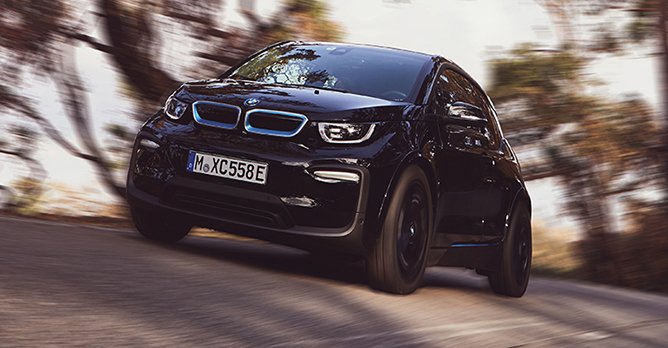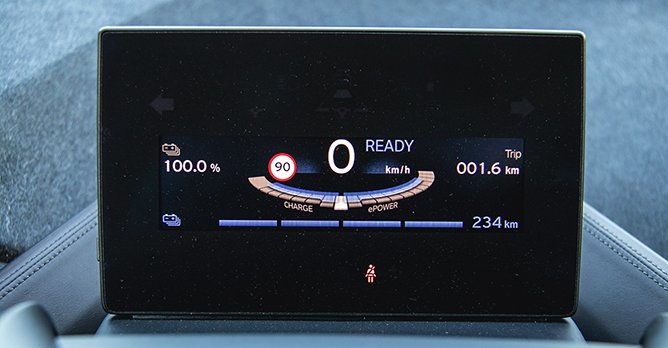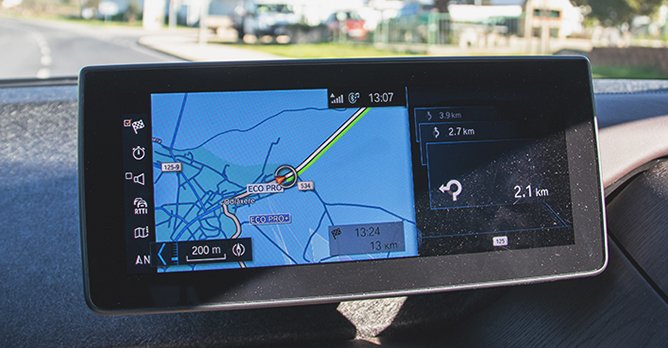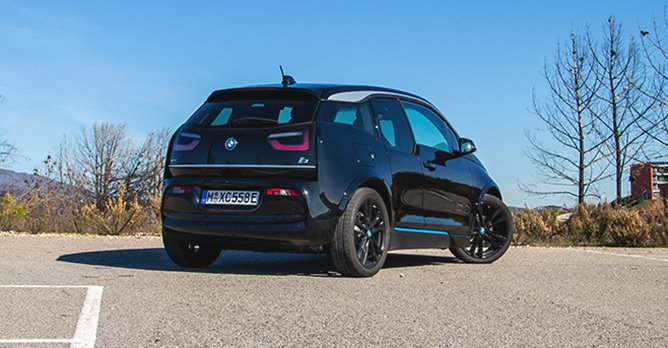BMW i3 120ah (A) First Drive Review
26 Dec 2018|8,239 views
What We Like
Improved range
Premium and well-insulated cabin
Perky powertrain makes for brisk acceleration
Premium badge
What We Dislike
Jittery ride
Not very spacious
A lot of the safety and assistance technologies are cost options
Back when it was first launched in 2013, the BMW i3 was something of a strange oddity in the automotive world - a premium, compact, all-electric hatchback creating a segment all of its own.
Five years on, and the i3 sees new competition, with cars like the Nissan Leaf and the Renault Zoe offering their own entries into the compact EV segment. Of course, the i3 has many things going for it - a premium badge, a snazzy exterior, a high-quality interior, and a sprightly drive. However, in the face of new competition, two aspects of the i3 stick out sorely - it's comparatively limited range, and its high price tag.
This, then, is the latest iteration of the i3, equipped with a new 120Ah battery to at least tackle one of those two key limitations.
So it's just a new battery?
The main change to the car lies under the car floor, in the form of a new 120Ah lithium-ion battery (double the capacity of the initial i3 offering). Importantly, the increase in battery capacity has come with no increase in battery size.
This of course means that the i3 now has more electric range, 30% more according to BMW. According to the WLTP cycle, the i3 has a range of 285 to 310km, though when we first jumped into the car it had 235km of range indicated on the dashboard (BMW tells us the car is capable of 260km of real world range). 235 to 260km of real world range is solid, and should cover most people's driving needs. It's not class-leading by any means, but any improvement is positive improvement.
Five years on, and the i3 sees new competition, with cars like the Nissan Leaf and the Renault Zoe offering their own entries into the compact EV segment. Of course, the i3 has many things going for it - a premium badge, a snazzy exterior, a high-quality interior, and a sprightly drive. However, in the face of new competition, two aspects of the i3 stick out sorely - it's comparatively limited range, and its high price tag.
This, then, is the latest iteration of the i3, equipped with a new 120Ah battery to at least tackle one of those two key limitations.
So it's just a new battery?
The main change to the car lies under the car floor, in the form of a new 120Ah lithium-ion battery (double the capacity of the initial i3 offering). Importantly, the increase in battery capacity has come with no increase in battery size.
This of course means that the i3 now has more electric range, 30% more according to BMW. According to the WLTP cycle, the i3 has a range of 285 to 310km, though when we first jumped into the car it had 235km of range indicated on the dashboard (BMW tells us the car is capable of 260km of real world range). 235 to 260km of real world range is solid, and should cover most people's driving needs. It's not class-leading by any means, but any improvement is positive improvement.
Anything else is new?
The updated model technically is offered with some 'new' options, such as a new 'Jucaro metallic' exterior colour, as well as optional Adaptive LED head lights that include the cornering light and the high beam assistant functions. Nothing groundbreaking or particularly remarkable here, as these are equipment already available on other BMW models.
Has the new battery radically change the car?
The updated i3 remains very much the car we are familiar with. It has all the standout characteristics of its predecessor (capable handling, high-quality cabin, overall quietness, perky acceleration) while also still possessing some of the same drawbacks (lumpy ride, cramped rear, a lot of tech are cost options). The car sold in Singapore is expected to be the full-spec model.
Having the new battery and increased range definitely helps to improve the value proposition of the i3. No doubt, it's an expensive car (or likely will be when its launched in Singapore next year), but at least it now delivers more range, allowing the i3 to keep pace with other electric cars in the market (purely when considering range).
The new i3 120Ah and i3s 120Ah will be launched in Singapore in the second quarter of next year.
The updated model technically is offered with some 'new' options, such as a new 'Jucaro metallic' exterior colour, as well as optional Adaptive LED head lights that include the cornering light and the high beam assistant functions. Nothing groundbreaking or particularly remarkable here, as these are equipment already available on other BMW models.
Has the new battery radically change the car?
The updated i3 remains very much the car we are familiar with. It has all the standout characteristics of its predecessor (capable handling, high-quality cabin, overall quietness, perky acceleration) while also still possessing some of the same drawbacks (lumpy ride, cramped rear, a lot of tech are cost options). The car sold in Singapore is expected to be the full-spec model.
Having the new battery and increased range definitely helps to improve the value proposition of the i3. No doubt, it's an expensive car (or likely will be when its launched in Singapore next year), but at least it now delivers more range, allowing the i3 to keep pace with other electric cars in the market (purely when considering range).
The new i3 120Ah and i3s 120Ah will be launched in Singapore in the second quarter of next year.
What We Like
Improved range
Premium and well-insulated cabin
Perky powertrain makes for brisk acceleration
Premium badge
What We Dislike
Jittery ride
Not very spacious
A lot of the safety and assistance technologies are cost options
Back when it was first launched in 2013, the BMW i3 was something of a strange oddity in the automotive world - a premium, compact, all-electric hatchback creating a segment all of its own.
Five years on, and the i3 sees new competition, with cars like the Nissan Leaf and the Renault Zoe offering their own entries into the compact EV segment. Of course, the i3 has many things going for it - a premium badge, a snazzy exterior, a high-quality interior, and a sprightly drive. However, in the face of new competition, two aspects of the i3 stick out sorely - it's comparatively limited range, and its high price tag.
This, then, is the latest iteration of the i3, equipped with a new 120Ah battery to at least tackle one of those two key limitations.
So it's just a new battery?
The main change to the car lies under the car floor, in the form of a new 120Ah lithium-ion battery (double the capacity of the initial i3 offering). Importantly, the increase in battery capacity has come with no increase in battery size.
This of course means that the i3 now has more electric range, 30% more according to BMW. According to the WLTP cycle, the i3 has a range of 285 to 310km, though when we first jumped into the car it had 235km of range indicated on the dashboard (BMW tells us the car is capable of 260km of real world range). 235 to 260km of real world range is solid, and should cover most people's driving needs. It's not class-leading by any means, but any improvement is positive improvement.
Five years on, and the i3 sees new competition, with cars like the Nissan Leaf and the Renault Zoe offering their own entries into the compact EV segment. Of course, the i3 has many things going for it - a premium badge, a snazzy exterior, a high-quality interior, and a sprightly drive. However, in the face of new competition, two aspects of the i3 stick out sorely - it's comparatively limited range, and its high price tag.
This, then, is the latest iteration of the i3, equipped with a new 120Ah battery to at least tackle one of those two key limitations.
So it's just a new battery?
The main change to the car lies under the car floor, in the form of a new 120Ah lithium-ion battery (double the capacity of the initial i3 offering). Importantly, the increase in battery capacity has come with no increase in battery size.
This of course means that the i3 now has more electric range, 30% more according to BMW. According to the WLTP cycle, the i3 has a range of 285 to 310km, though when we first jumped into the car it had 235km of range indicated on the dashboard (BMW tells us the car is capable of 260km of real world range). 235 to 260km of real world range is solid, and should cover most people's driving needs. It's not class-leading by any means, but any improvement is positive improvement.
Anything else is new?
The updated model technically is offered with some 'new' options, such as a new 'Jucaro metallic' exterior colour, as well as optional Adaptive LED head lights that include the cornering light and the high beam assistant functions. Nothing groundbreaking or particularly remarkable here, as these are equipment already available on other BMW models.
Has the new battery radically change the car?
The updated i3 remains very much the car we are familiar with. It has all the standout characteristics of its predecessor (capable handling, high-quality cabin, overall quietness, perky acceleration) while also still possessing some of the same drawbacks (lumpy ride, cramped rear, a lot of tech are cost options). The car sold in Singapore is expected to be the full-spec model.
Having the new battery and increased range definitely helps to improve the value proposition of the i3. No doubt, it's an expensive car (or likely will be when its launched in Singapore next year), but at least it now delivers more range, allowing the i3 to keep pace with other electric cars in the market (purely when considering range).
The new i3 120Ah and i3s 120Ah will be launched in Singapore in the second quarter of next year.
The updated model technically is offered with some 'new' options, such as a new 'Jucaro metallic' exterior colour, as well as optional Adaptive LED head lights that include the cornering light and the high beam assistant functions. Nothing groundbreaking or particularly remarkable here, as these are equipment already available on other BMW models.
Has the new battery radically change the car?
The updated i3 remains very much the car we are familiar with. It has all the standout characteristics of its predecessor (capable handling, high-quality cabin, overall quietness, perky acceleration) while also still possessing some of the same drawbacks (lumpy ride, cramped rear, a lot of tech are cost options). The car sold in Singapore is expected to be the full-spec model.
Having the new battery and increased range definitely helps to improve the value proposition of the i3. No doubt, it's an expensive car (or likely will be when its launched in Singapore next year), but at least it now delivers more range, allowing the i3 to keep pace with other electric cars in the market (purely when considering range).
The new i3 120Ah and i3s 120Ah will be launched in Singapore in the second quarter of next year.
Thank You For Your Subscription.








































